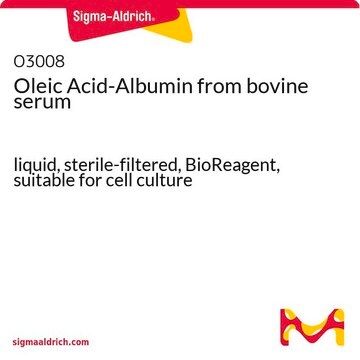Unfortunately, the stability of this product in solution is not determined.
Kluczowe dokumenty
P5585
Palmitic acid
BioXtra, ≥99%
Synonim(y):
1-Pentadecanecarboxylic acid, C16:0, Cetylic acid, Hexadecanoic acid, NSC 5030, PamOH
Wybierz wielkość
473,00 zł
Wybierz wielkość
About This Item
473,00 zł
Polecane produkty
pochodzenie biologiczne
plant (vegetable)
Poziom jakości
ciśnienie pary
10 mmHg ( 210 °C)
linia produktu
BioXtra
Próba
≥99%
Formularz
powder
metody
cell culture | mammalian: suitable
zanieczyszczenia
≤0.0005% Phosphorus (P)
≤0.1% Insoluble matter
pozostałość po prażeniu
≤0.1%
bp
271.5 °C/100 mmHg (lit.)
mp
61-62.5 °C (lit.)
rozpuszczalność
chloroform: 0.5 M, clear, colorless
gęstość
0.852 g/mL at 25 °C (lit.)
ślady anionów
chloride (Cl-): ≤0.05%
sulfate (SO42-): ≤0.05%
ślady kationów
Al: ≤0.005%
Ca: ≤0.0005%
Cu: ≤0.0005%
Fe: ≤0.0005%
K: ≤0.005%
Mg: ≤0.0005%
NH4+: ≤0.05%
Na: ≤0.05%
Pb: ≤0.001%
Zn: ≤0.0005%
grupa funkcyjna
carboxylic acid
typ lipidu
saturated FAs
Warunki transportu
ambient
temp. przechowywania
room temp
ciąg SMILES
CCCCCCCCCCCCCCCC(O)=O
InChI
1S/C16H32O2/c1-2-3-4-5-6-7-8-9-10-11-12-13-14-15-16(17)18/h2-15H2,1H3,(H,17,18)
Klucz InChI
IPCSVZSSVZVIGE-UHFFFAOYSA-N
informacje o genach
human ... FABP2(2169) , FABP3(2170) , FABP4(2167) , FABP5(2171)
Szukasz podobnych produktów? Odwiedź Przewodnik dotyczący porównywania produktów
Zastosowanie
Działania biochem./fizjol.
Kod klasy składowania
11 - Combustible Solids
Klasa zagrożenia wodnego (WGK)
nwg
Temperatura zapłonu (°F)
235.4 °F
Temperatura zapłonu (°C)
113 °C
Środki ochrony indywidualnej
dust mask type N95 (US), Eyeshields, Gloves
Wybierz jedną z najnowszych wersji:
Certyfikaty analizy (CoA)
Nie widzisz odpowiedniej wersji?
Jeśli potrzebujesz konkretnej wersji, możesz wyszukać konkretny certyfikat według numeru partii lub serii.
Masz już ten produkt?
Dokumenty związane z niedawno zakupionymi produktami zostały zamieszczone w Bibliotece dokumentów.
Klienci oglądali również te produkty
Produkty
Lipid Induced Insulin Resistance
Fatty acid synthesis supports cancer cell proliferation, essential for membrane generation, protein modification, and bioenergetics.
-
I want to know the storage temperature after reconstituting the product in the solvent? Also clarify regarding the type of solvent to be used?
1 answer-
Helpful?
-
-
How is shipping temperature determined? And how is it related to the product storage temperature?
1 answer-
Products may be shipped at a different temperature than the recommended long-term storage temperature. If the product quality is sensitive to short-term exposure to conditions other than the recommended long-term storage, it will be shipped on wet or dry-ice. If the product quality is NOT affected by short-term exposure to conditions other than the recommended long-term storage, it will be shipped at ambient temperature. As shipping routes are configured for minimum transit times, shipping at ambient temperature helps control shipping costs for our customers. For more information, please refer to the Storage and Transport Conditions document: https://www.sigmaaldrich.com/deepweb/assets/sigmaaldrich/marketing/global/documents/316/622/storage-transport-conditions-mk.pdf
Helpful?
-
-
How can I determine the shelf life / expiration / retest date of this product?
1 answer-
If this product has an expiration or retest date, it will be shown on the Certificate of Analysis (COA, CofA). If there is no retest or expiration date listed on the product's COA, we do not have suitable stability data to determine a shelf life. For these products, the only date on the COA will be the release date; a retest, expiration, or use-by-date will not be displayed.
For all products, we recommend handling per defined conditions as printed in our product literature and website product descriptions. We recommend that products should be routinely inspected by customers to ensure they perform as expected.
For products without retest or expiration dates, our standard warranty of 1 year from the date of shipment is applicable.
For more information, please refer to the Product Dating Information document: https://www.sigmaaldrich.com/deepweb/assets/sigmaaldrich/marketing/global/documents/449/386/product-dating-information-mk.pdfHelpful?
-
-
I am curious about the storage temperature of this product.
1 answer-
As listed in the PROPERTIES section of the product page, this product may be stored at room temperature.
Helpful?
-
-
Can you tell me the storage temperature for this product?
1 answer-
As stated in the PROPERTIES section of the product page, this product is stored at room temperature.
Helpful?
-
-
Is this product soluble only in chloroform? Did you know something about its solubility in ethanol or DMSO?
1 answer-
Stock solutions of palmitic acid can be prepared in 200 proof ethanol or DMSO at 20 mg/mL. Stock solutions should be purged with inert gas, such as argon or nitrogen, prior to storage.
Helpful?
-
Active Filters
Nasz zespół naukowców ma doświadczenie we wszystkich obszarach badań, w tym w naukach przyrodniczych, materiałoznawstwie, syntezie chemicznej, chromatografii, analityce i wielu innych dziedzinach.
Skontaktuj się z zespołem ds. pomocy technicznej





